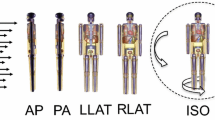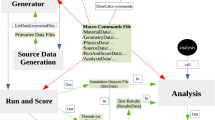Abstract
Neutron dose coefficients for standard irradiation geometries have been reported in International Commission on Radiological Protection (ICRP) Publication 116 for the ICRP Publication 110 adult reference phantoms. In the present work, organ and effective dose coefficients have been calculated for a receptor in both upright and articulated (bent) postures representing more realistic working postures exposed to a mono-energetic neutron radiation field. This work builds upon prior work by Dewji and co-workers comparing upright and bent postures for exposure to mono-energetic photon fields. Simulations were conducted using the Oak Ridge National Laboratory’s articulated stylized adult phantom, “Phantom wIth Moving Arms and Legs” (PIMAL) software package, and the Monte Carlo N-Particle (MCNP) version 6.1.1 radiation transport code. Organ doses were compared for the upright and bent (45° and 90°) phantom postures for neutron energies ranging from 1 × 10− 9 to 20 MeV for the ICRP Publication 116 external exposure geometries—antero-posterior (AP), postero-anterior (PA), and left and right lateral (LLAT, RLAT). Using both male and female phantoms, effective dose coefficients were computed using ICRP Publication 103 methodology. The resulting coefficients for articulated phantoms were compared to those of the upright phantom. Computed organ and effective dose coefficients are discussed as a function of neutron energy, phantom posture, and source irradiation geometry. For example, it is shown here that for the AP and PA irradiation geometries, the differences in the organ coefficients between the upright and bent posture become more pronounced with increasing bending angle. In the AP geometry, the brain dose coefficients are expectedly higher in the bent postures than in the upright posture, while all other organs have lower dose coefficients, with the thyroid showing the greatest difference. Overall, the effective dose estimated for the upright phantom is more conservative than that for the articulated phantom, which may have ramifications in the estimation or reconstruction of radiation doses.















Similar content being viewed by others
Notes
Supplemental electronic data have been provided in Tables 5–40 and Figs. 16–25 for sex-specific organ dose coefficients for all organs and neutron energies for AP, PA, LLAT, and RLAT irradiation geometries.
See supplemental electronic data: Tables 27–28 for organ-absorbed dose for thyroid and Fig. 16 for ratio plot.
See supplemental electronic data: Table 11 for organ-absorbed dose for testes and Fig. 24 for ratio plot.
An expanded library of graphs of the ratios comparing the postures to the upright PIMAL phantom has been provided as electronic supplemental material as Figs. 16–25 for each sex-averaged organs and the AP, PA, LLAT, and RLAT sources.
References
Akkurt H, Eckerman KF (2007) Development of PIMAL: mathematical phantom with moving arms and legs, ORNL/TM-2007/14. Oak Ridge National Laboratory, Oak Ridge
Akkurt H, Bekar K, Eckerman KF (2009) Assessment of organ doses for a glovebox worker using realistic postures with PIMAL and VOXMAT. Trans Am Nucl Soc 101:671–673
Alves M, Santos W, Lee C, Bolch W, Hunt J, Júnior AC (2016) Conversion coefficients for proton beams using standing and sitting male hybrid computational phantom calculated in idealized irradiation geometries. Radiat Prot Dosim 175(1):75–86
Barnard SG, Ainsbury EA, Quinlan RA, Bouffler SD (2016) Radiation protection of the eye lens in medical workers—basis and impact of the ICRP recommendations. Brit J Radiol 89(1060):20151034
Bellamy MB, Hiller MM, Dewji SA, Veinot KG, Leggett RW, Eckerman KF, Easterly C, Hertel NE (2016) Comparison of monoenergetic photon organ dose rate coefficients for stylized and voxel phantoms submerged in air. Radiat Prot Dosim 172(4):367–374
Dewji SA, Hiller MM (2016) PIMAL: phantom with moving arms and legs version 4.1.0. US Nuclear Regulatory Commission, Rockville
Dewji SA, Bellamy MB, Hertel NE, Leggett RW, Sherbini S, Saba MS, Eckerman KF (2015) Estimated dose rates to members of the public from external exposure to patients with 131I thyroid treatment. Med Phys 42(4):1851–1857
Dewji SA, Reed KL, Hiller MM (2017) Comparison of organ doses for PIMAL stylized phantoms in upright and bent positions for standard irradiation geometries. Radiat Environ Biophys 56(3):277–291
Han EY, Ha W-H, Jin Y-W, Bolch WE, Lee C (2014) Effective dose conversion coefficients for health care provider exposed to pediatric and adult victims in radiological dispersal device incident. J Radiol Prot 35(1):37–45
Hiller M, Dewji SA (2017) Comparison of monoenergetic photon organ dose rate coefficients for the female stylized and voxel phantoms submerged in air. Radiat Prot Dosim 175(3):336–343
International Commission on Radiological Protection (1996) ICRP Publication 74: conversion coefficients for use in radiological protection against external radiation. In: Annals of the ICRP 26:(3–4)
International Commission on Radiological Protection (2002) ICRP Publication 89: basic anatomical and physiological data for use in radiological protection: reference values. In: Annals of the ICRP 32
International Commission on Radiological Protection (2007) ICRP Publication 103: the 2007 recommendations of the international commission on radiological protection. In: Annals of the ICRP 37
International Commission on Radiological Protection (2009) ICRP Publication 110: adult reference computational phantoms. In: Annals of the ICRP 39
International Commission on Radiological Protection (2010) ICRP Publication 116: conversion coefficients for radiological protection quantities for external radiation exposures. In: Annals of the ICRP 40
Pelowitz DB, Fallgren AJ, McMath GE (2014) MCNP6 user’s manual, code version 6.1.1 beta. Los Alamos National Laboratory, Los Alamos
Vazquez JA, Caracappa PF, Xu XG (2014) Development of posture-specific computational phantoms using motion capture technology and application to radiation dose-reconstruction for the 1999 Tokai-Mura nuclear criticality accident. Phys Med Biol 59(18):5277–5286
Xu XG (2014) An exponential growth of computational phantom research in radiation protection, imaging, and radiotherapy: a review of the fifty-year history. Phys Med Biol 59(18):R233–R302
Acknowledgements
The authors would like to thank Dr. Keith Eckerman and Dr. Ken Veinot for their invaluable feedback on this work. This work was supported in part by the U.S. Department of Energy, Office of Science, Office of Workforce Development for Teachers and Scientists (WDTS) under the Science Undergraduate Laboratory Internship program and by the United States Nuclear Regulatory Commission under Contract no. NRCHQ6017D0003.
Author information
Authors and Affiliations
Corresponding author
Additional information
This manuscript has been authored by UT-Battelle, LLC, under Contract no. DE-AC0500OR22725 with the U.S. Department of Energy. The United States Government retains and the publisher, by accepting the article for publication, acknowledges that the United States Government retains a non-exclusive, paid-up, irrevocable, worldwide license to publish or reproduce the published form of this manuscript, or allow others to do so, for the United States Government purposes. The Department of Energy will provide public access to these results of federally sponsored research in accordance with the DOE Public Access Plan (http://energy.gov/downloads/doe-public-access-plan).
Electronic supplementary material
Below is the link to the electronic supplementary material.
Rights and permissions
About this article
Cite this article
Bales, K., Dewji, S. & Sanchez, E. Comparison of neutron organ and effective dose coefficients for PIMAL stylized phantom in bent postures in standard irradiation geometries. Radiat Environ Biophys 57, 375–393 (2018). https://doi.org/10.1007/s00411-018-0751-8
Received:
Accepted:
Published:
Issue Date:
DOI: https://doi.org/10.1007/s00411-018-0751-8




